
MOUNT CARMEL, ISRAEL--The Natufian hunter-gatherers who lived in Raqefet Cave some 14,000 years ago are the earliest known prehistoric people to systematically bury their dead in cemeteries, and they may have been the ancestors of the first farmers. Recent excavations at the cave, which consists of five chambers, have uncovered 29 skeletons so far. Dani Nadel of the University of Haifa has shown that four of those individuals, including a double burial of a man and an adolescent boy, had been buried on a bed of flowers and plants. The graves were cut out of the limestone bedrock floor of the cave, and then lined with a thin layer of mud, which preserved impressions of the stems of Judean sage, mint, figwort, and other aromatic and flowering plants. Phytoliths from grasses, shrubs, reeds, and sedges were also found in the four graves. This “is the oldest example of putting flowers and fresh plants in the grave before burying the dead,” Nadel said.










